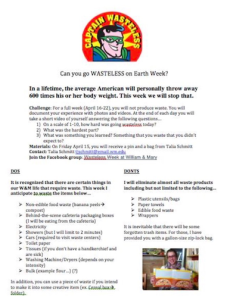For the past 46 years, people around the nation have spent April 22 celebrating Earth Day by both cleaning and protecting the Earth. Earth Day’s website explains how, on April 22, 1970 the Environmental movement came to life through demonstrations and rallies all around the United States thanks to then-U.S. Sen. from Wisconsin, Gaylord Nelson.

Now, at the College of William and Mary since 2011, William and Mary Sustainability Organization hosts an entire week of awareness raising activities dedicated to the Earth. With this year’s theme “The World Around Us,” a group of students, including myself and my co-blogger, Talia Schmitt, will be attempting to survive the week of April 16 to 22 without producing waste. Aside from a much lighter garbage bag, this means avoiding a large amount of products we generally consumer on a daily basis.
In food waste alone, William and Mary students wasted 174 tons of food in 2015. Not just on the College’s campus, but also all over the U.S. we have developed this culture around disposable property, whether it is a paper towel or old, beaten up car. We have made throwing things “away” as normal as eating breakfast or taking a shower, but the problem with this is there is no real “away.” As wonderful a concept as this is with renewable resources, it also means that the Styrofoam egg carton thrown away yesterday will likely still be around long after the garbage truck picks it up; like 500 years after. According to a report by the U.S. Environmental Protection Agency in 2013, Americans generated about 254 million tons of trash. Even with recycling, most products must be degraded instead of fully recycled, and the process emits huge amounts of green house gases. The EPA says that 42 percent of U.S. greenhouse gas emissions derive from producing, processing, transporting and disposing of our food and goods.

For the “wasteless” week, we hope to monitor how much waste we use each day — what we could and could not avoid, or what was most difficult not to use. Although we will try to restrict generating waste from sources such as paper towels, plastic utensils, bad, edible food waste and wrappers of any sort, there are certain necessities that our College campus life requires. These include things such as non-edible food waste, behind-the-scenes cafeteria packaging, electricity, showers, toilet paper and tissues. Additionally, any waste products that can be up-cycled, or put to a new use, will not count as waste.
Everyone is welcome to participate in the “Wasteless” challenge for Earth Week, whether publicly or just thinking about it in the back of your head. If this appeals to you, I would encourage anyone to join me and Talia, as well as a handful of other students, in what I expect will be an eye-opening experience.

